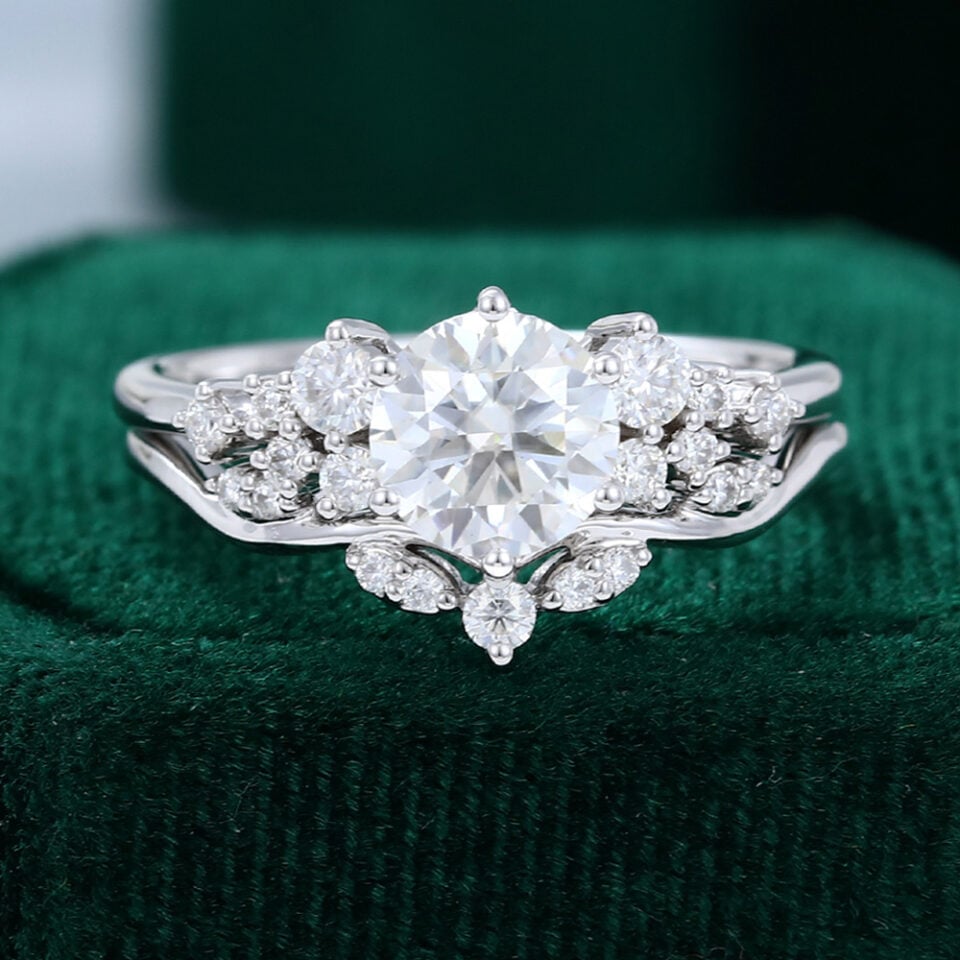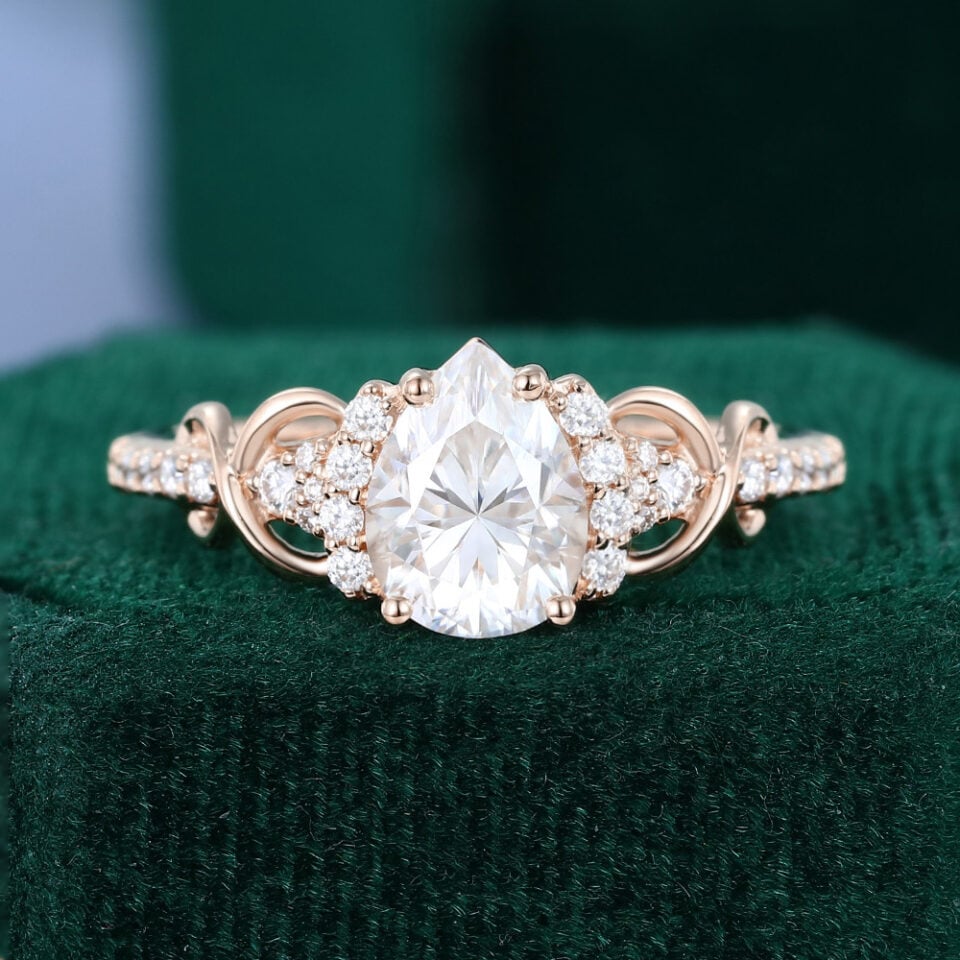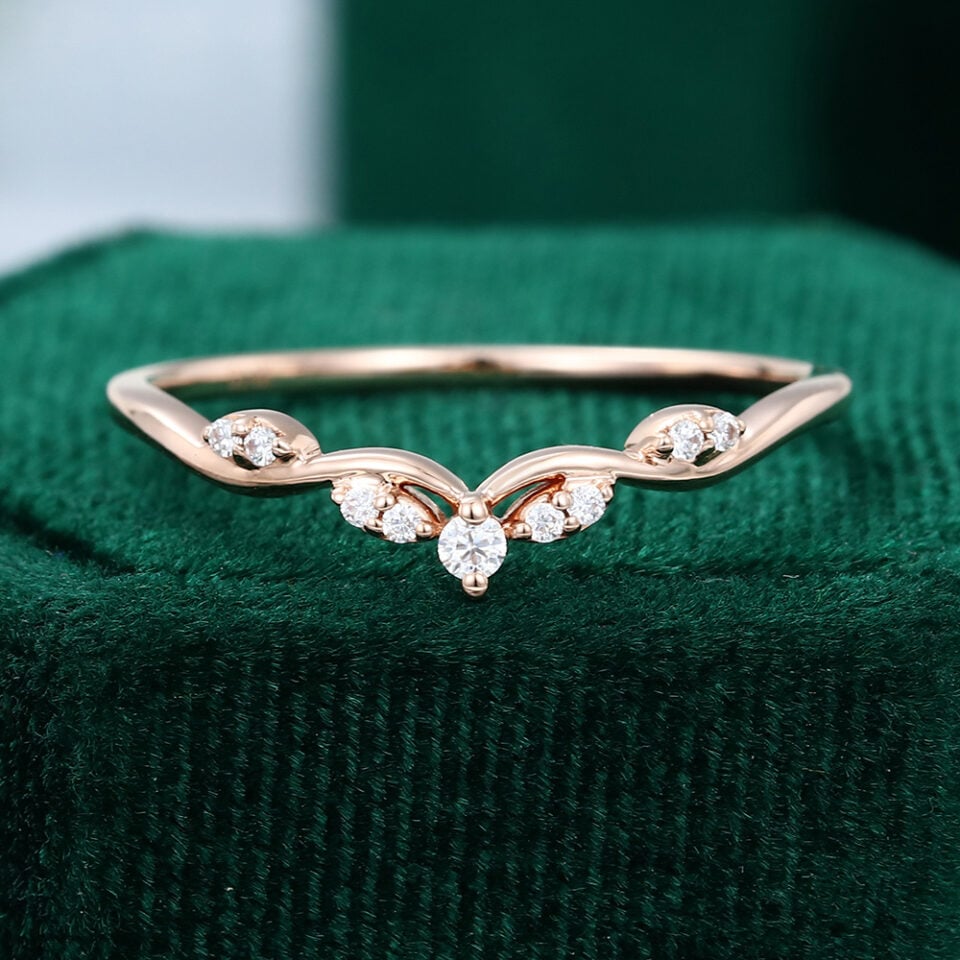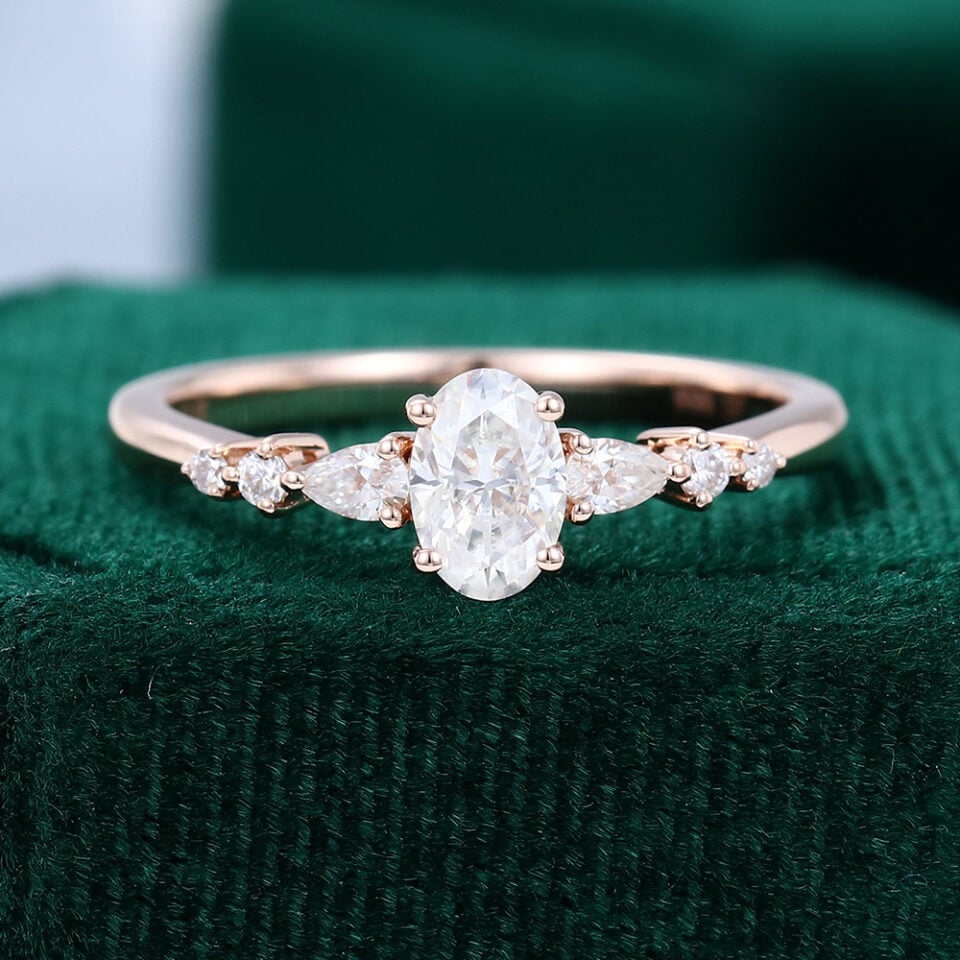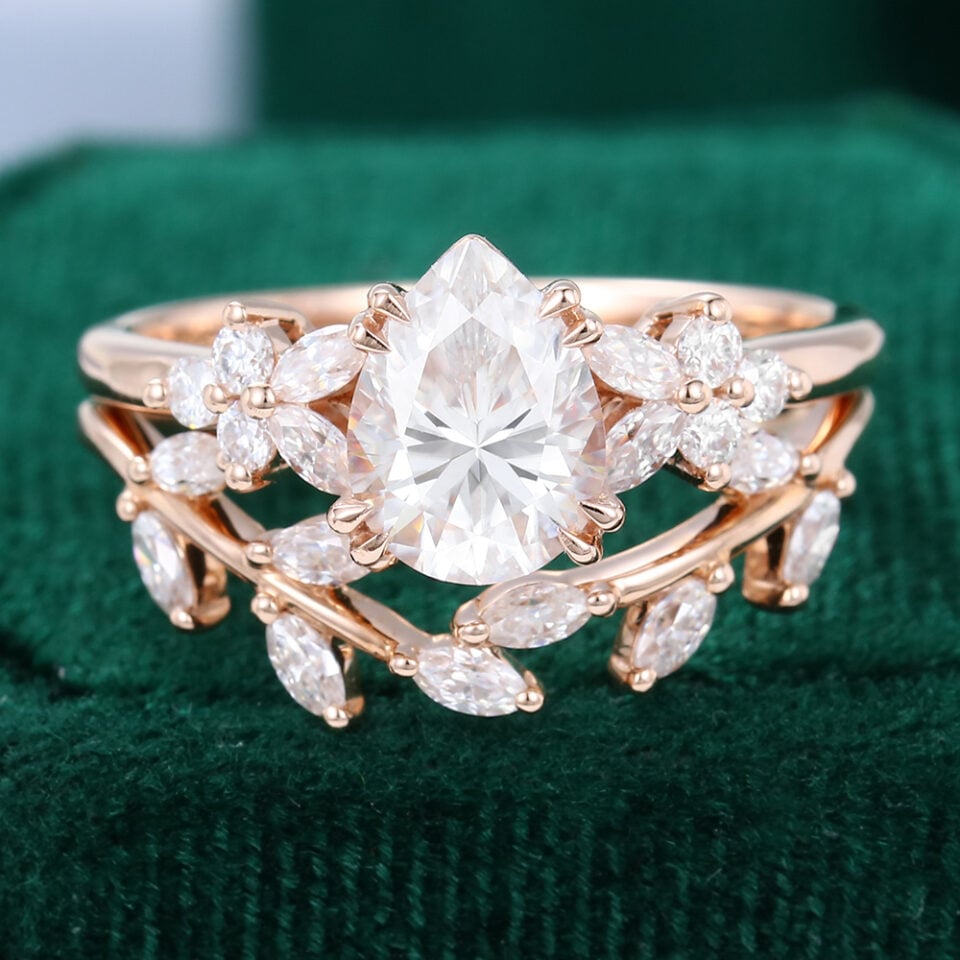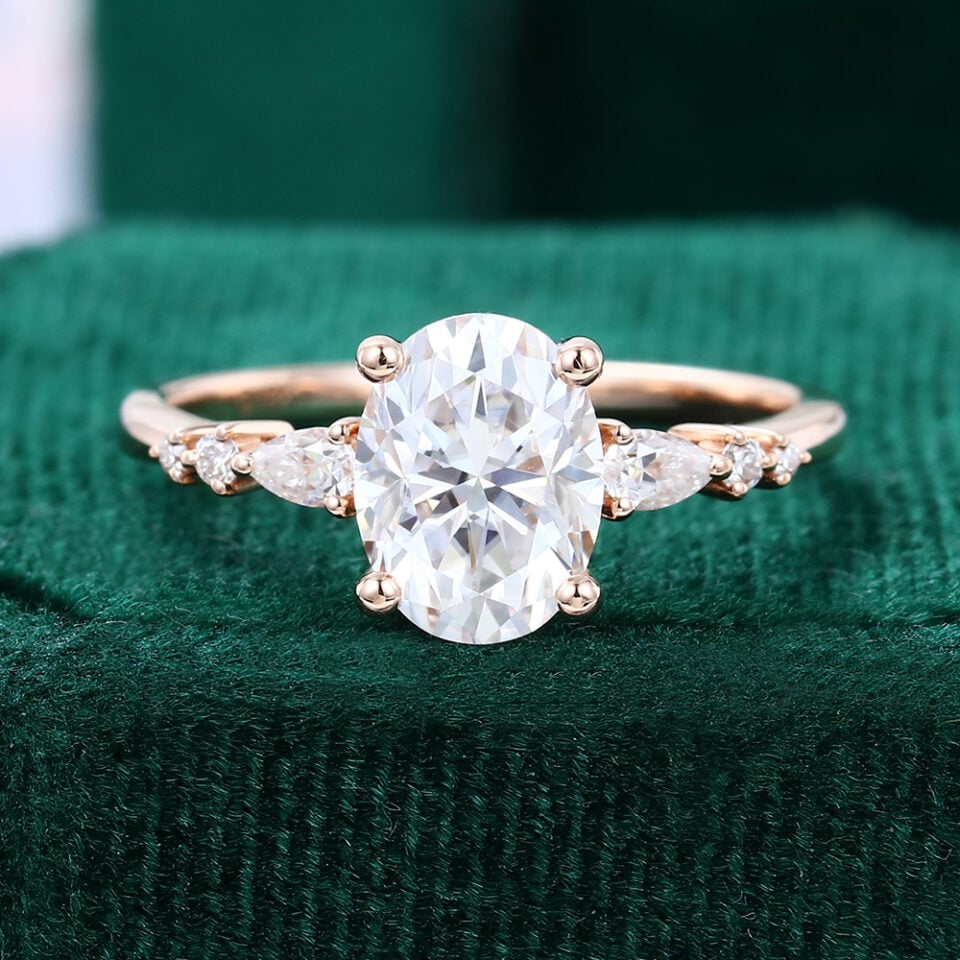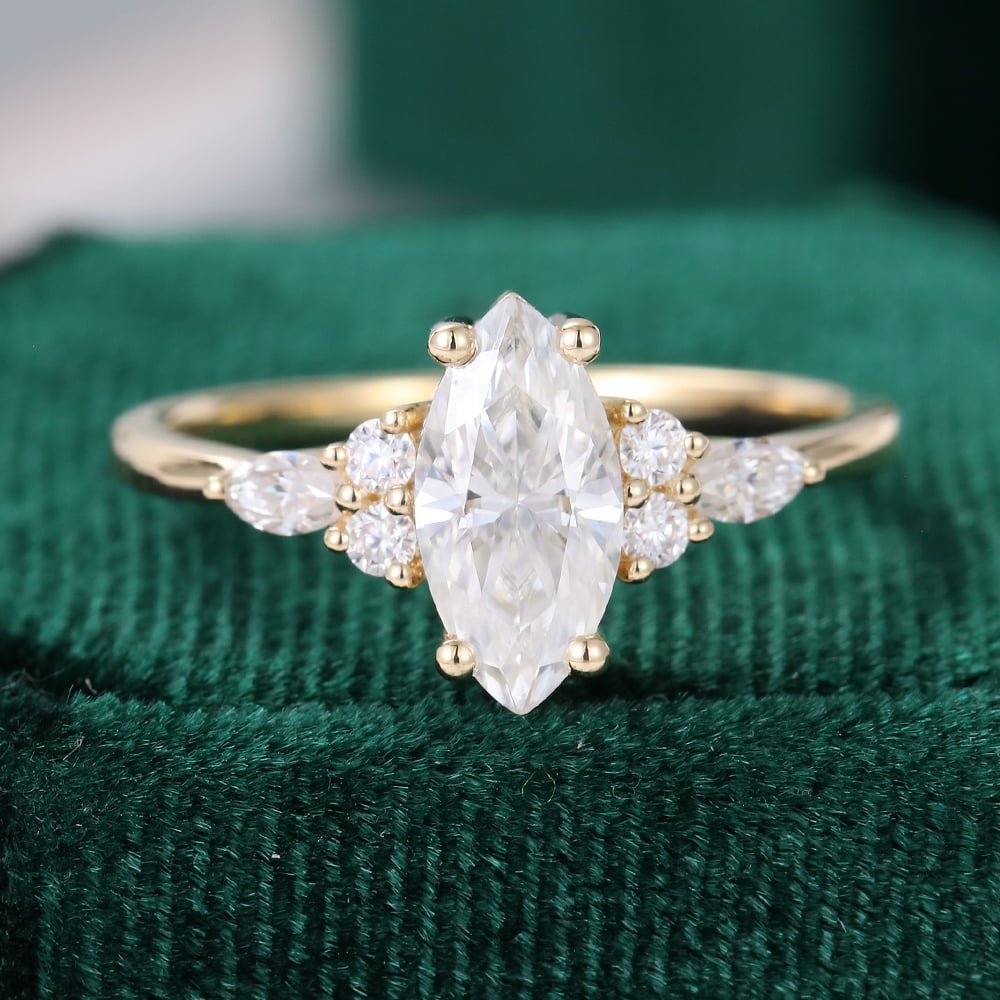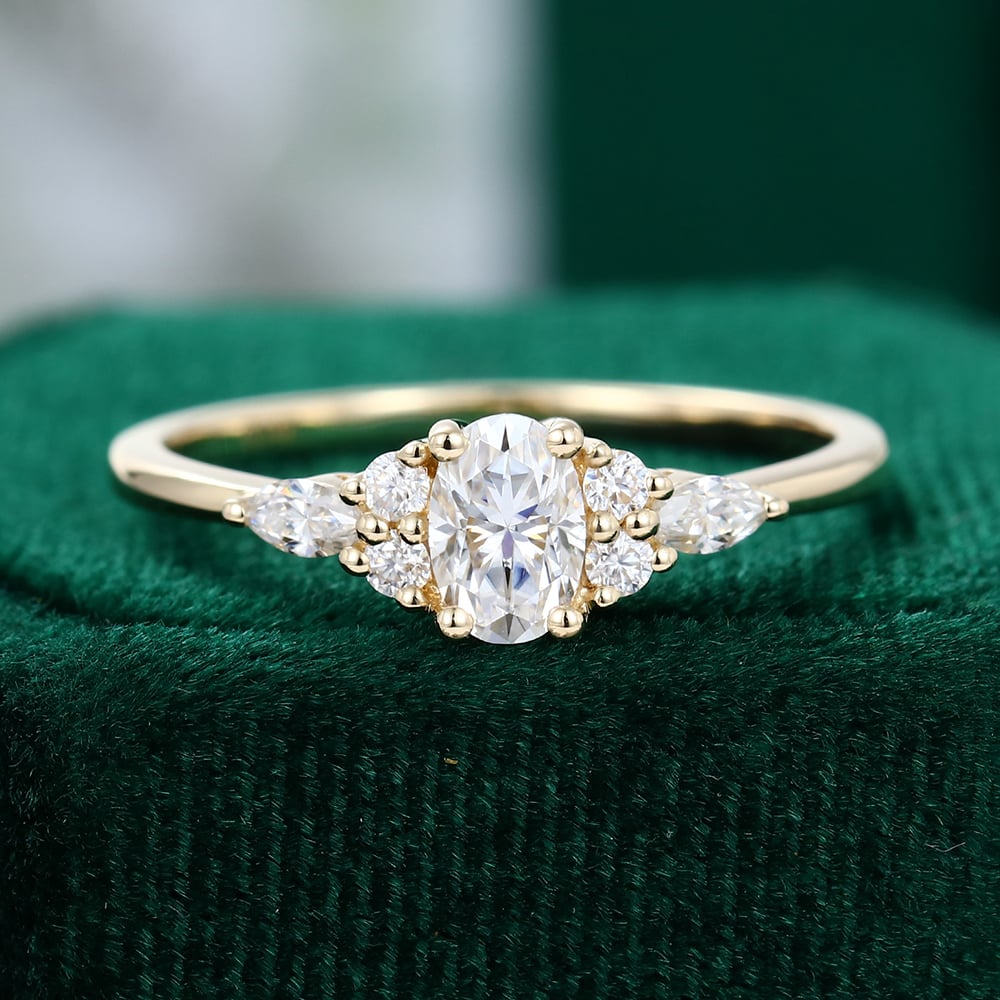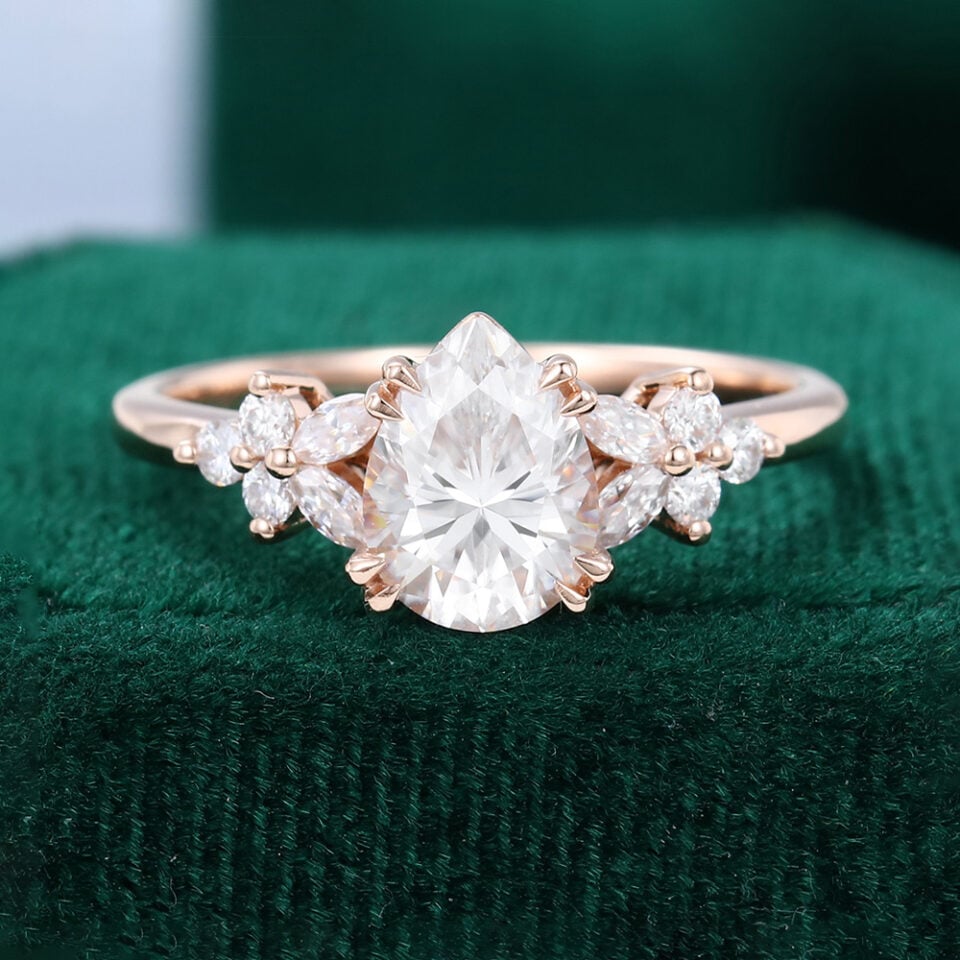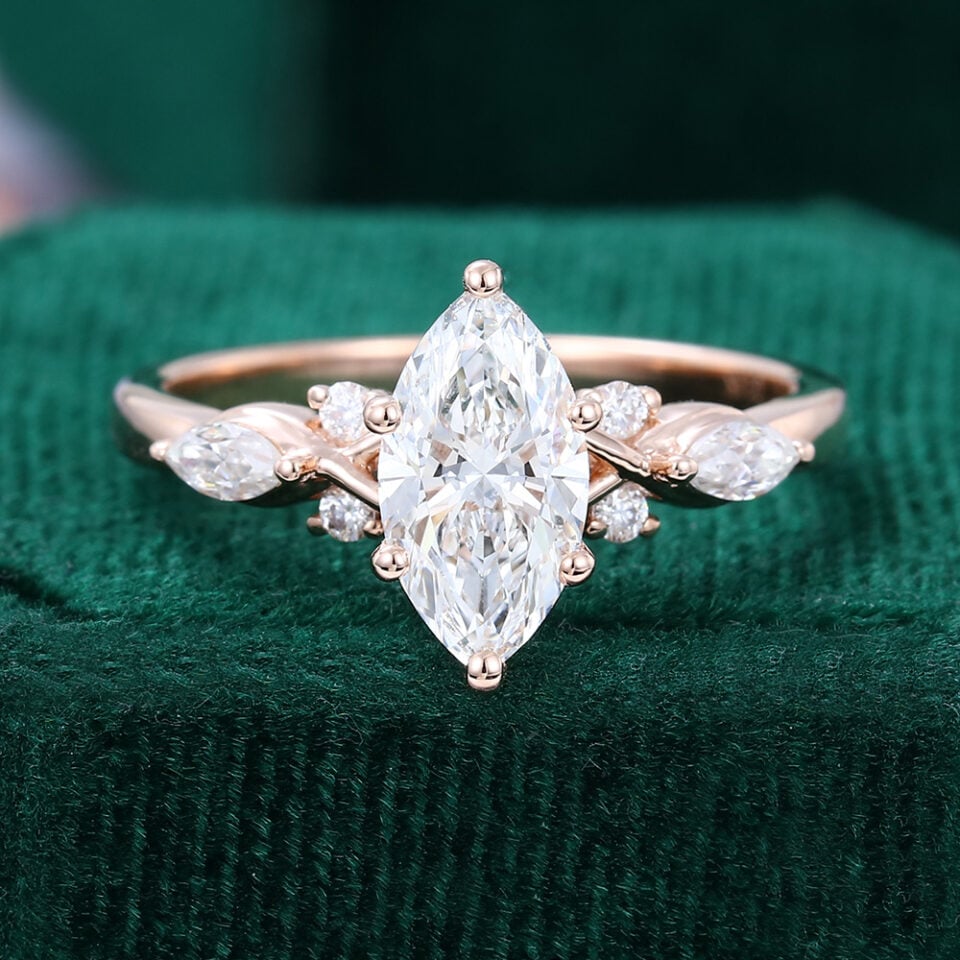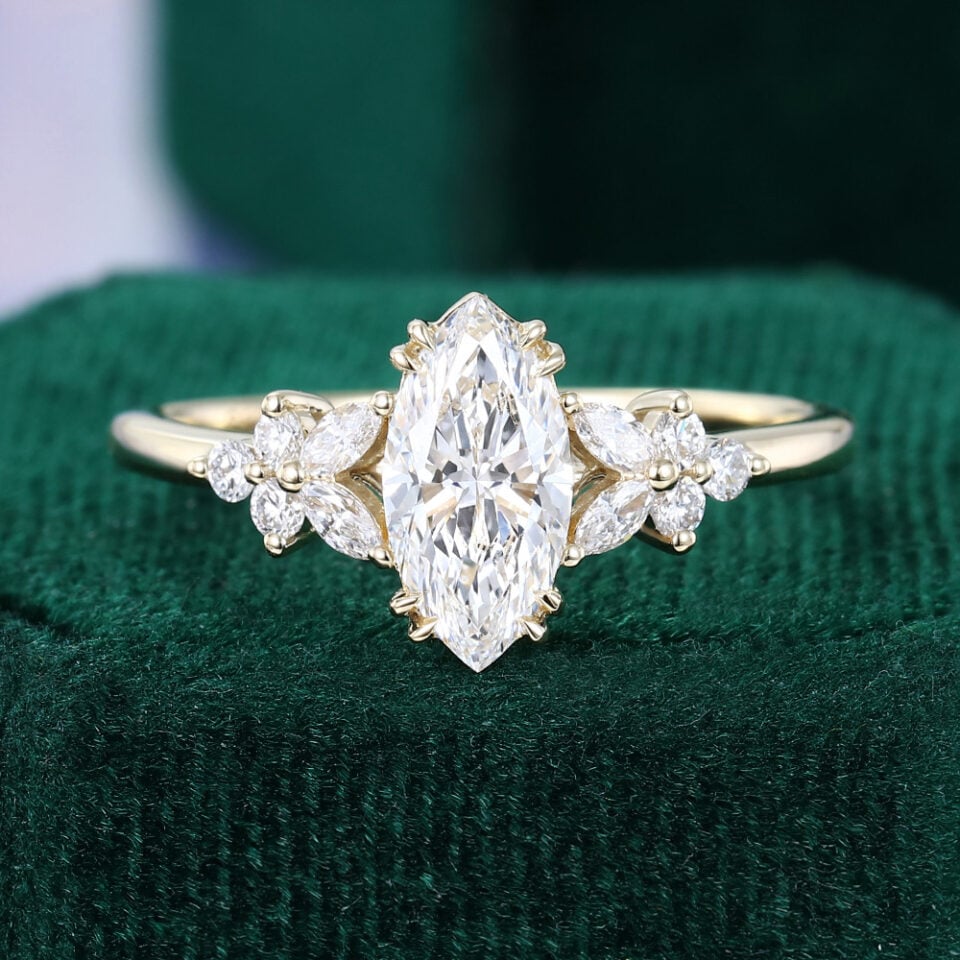- by MollyJewelryUS
- January 17, 2022
- About Moissanite
When shopping for an engagement ring or fine jewelry, choosing the right stone is a big decision. Natural diamonds, Lab Diamonds, moissanite, and cubic zirconia (CZ) are four of the most popular clear stones on the market. While they can look similar at first glance, they differ greatly in sparkle, durability, price, and long-term value.
This guide compares moissanite vs diamond vs CZ side-by-side to help you make the best choice for your lifestyle, budget, and personal preferences. Before we begin, if you’re unfamiliar with what moissanite is, please refer to our guide“What Is Moissanite?”
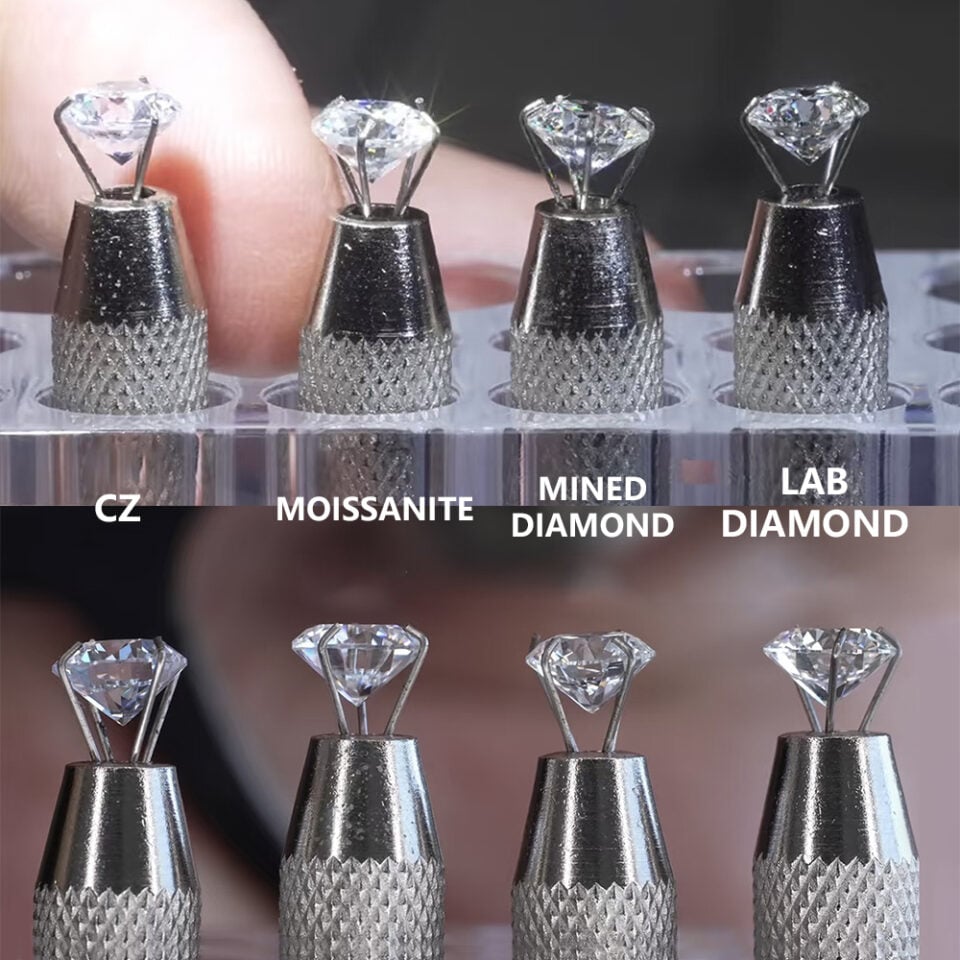
Moissanite vs Diamond vs CZ: A Quick Comparison
Moissanite vs Diamond vs CZ: A Quick Comparison
From hardness and sparkle to price range and how they react to a tester pen, here’s a straightforward comparison table that makes it easier to understand what you’re really getting.
| Feature | Natural Diamond | Lab-Grown Diamond | Moissanite | Cubic Zirconia (CZ) |
|---|---|---|---|---|
| Origin | Formed naturally underground over billions of years | Grown in labs using HPHT or CVD methods | Lab-created from silicon carbide | Fully synthetic, made from zirconium dioxide |
| Price Range (per carat) | $$$$ (Highest) | $$$ (40–70% less than natural diamond) | $$ (Affordable luxury) | $ (Very low cost) |
| Hardness (Mohs Scale) | 10 | 10 | 9.25 | 8–8.5 |
| Brilliance & Fire | Balanced white brilliance, elegant sparkle | Same as natural diamond | Strong rainbow-like fire, very sparkly | Bright at first, dulls over time |
| Durability | Extremely durable, ideal for daily wear | Equally durable | Very durable, resists scratching | Softer, scratches easily |
| Tester Result | Positive (conducts heat/electricity) | Positive (same as natural) | May read as “diamond” on some testers | Negative |
| Symbolism & Value | Traditional symbol of rarity and status | Modern, ethical choice with real diamond structure | Ethical, affordable, and eye-catching | Fashion or temporary alternative |
Moissanite vs Diamond
Moissanite vs Diamond
Moissanite and natural diamonds can appear almost identical to the untrained eye; both are clear, sparkly, and commonly used in engagement rings. So, which is more ideal for daily wear, and why do their prices diverge? Let’s dig deeper into their differences.
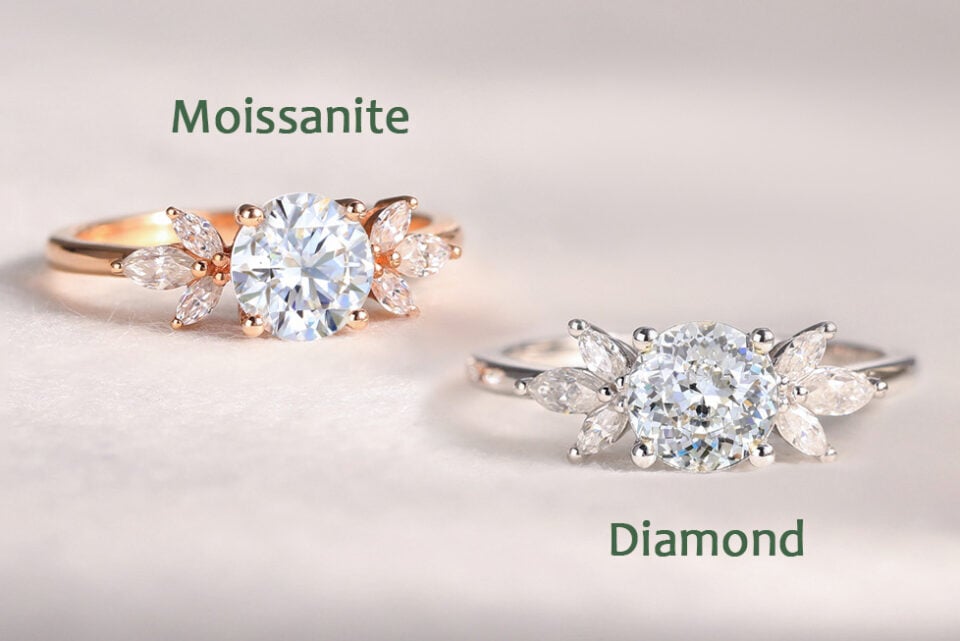
Appearance:
Appearance:
Both stones are clear and sparkly, but moissanite actually has more fire and brilliance than a diamond. Under lighting, moissanite often shows more rainbow flashes, while diamonds reflect more white light with a more traditional shimmer. Some people love the extra sparkle that moissanite gives, while others prefer the more subdued shimmer of a diamond.
Hardness:
Hardness:
Diamonds are the hardest known natural material, rated 10 on the Mohs scale — but moissanite is close behind at 9.25. In real-life wear, the difference is negligible. Both stones are excellent for daily use, including engagement rings, with moissanite offering impressive toughness and scratch resistance.
Price & Value:
Price & Value:
Here’s where the difference really becomes clear. A high-quality 1-carat natural diamond can cost anywhere from $4,000 to $10,000 or more, depending on its color, clarity, and cut. In comparison, a 1-carat moissanite stone typically sells for between $200 and $500, and is of superior color and clarity.
This raises an important point:
” A truly good diamond is expensive, and a cheap diamond often isn’t worth it. “
Lower-priced natural diamonds often come with compromises: visible inclusions, poor cut proportions, or noticeable yellow tint. Moissanite, on the other hand, is lab-created to high clarity and color standards, giving you a consistently beautiful look, without having to stretch your budget or lower your expectations.
Emotional Value vs Practicality
Emotional Value vs Practicality
Some people simply want a diamond for its tradition, rarity, or symbolic status — and that’s perfectly valid. But for couples who care more about ethics and value, moissanite offers an undeniable advantage.
Moissanite vs Lab Created Diamond
Moissanite vs Lab Created Diamond
If you’re looking for a more ethical, affordable alternative to mined diamonds, chances are you’ve come across lab-grown diamonds. They share a lot in common with moissanite: both are lab-created, conflict-free, and visually stunning. However, they’re not the same stone, and the differences are worth noting.

Composition & Appearance
Composition & Appearance
Lab-grown diamonds are chemically identical to natural diamonds and have the same physical properties. They’re made of pure carbon, just grown in a lab instead of underground. Moissanite, however, is made of silicon carbide, a completely different material with a higher refractive index. Moissanite actually has more fire and sparkle than any type of diamond, lab-grown or natural.
In short, lab-grown diamonds give you that traditional diamond look. Moissanite offers a more fiery, rainbow-like sparkle that stands out more under lighting. It’s not better or worse, it depends on your style.
Durability:
Durability:
Both stones are durable enough for a lifetime of daily wear. Lab-grown diamonds are a perfect 10 on the Mohs scale, and moissanite’s 9.25 is just a touch below. In real life? Both are tough, scratch-resistant, and ring-worthy.
Price:
Price:
Here’s where moissanite really stands out. While lab-grown diamonds are far more affordable than mined ones, they’re still significantly more expensive than moissanite. Typically, moissanite is 30–70% less expensive than lab-grown diamonds of comparable size and quality.
That’s a big difference, especially if you’re shopping on a budget or prefer to put your savings toward something else (like your honeymoon, wedding, or future home).
Style, Values & Practicality
Style, Values & Practicality
Both moissanite and lab-grown diamonds appeal to couples who care about sustainability and ethics; there’s no mining involved, no conflict concerns. But if your top priorities include maximum sparkle, budget-friendliness, and bold beauty, moissanite delivers more for less.
Lab-grown diamonds are ideal for those who want that classic diamond identity without the traditional price tag. Moissanite is better suited to those who want a little more sparkle and a lot more value.
Price Comparison: Moissanite vs Diamond
Price Comparison: Moissanite vs Diamond
One of the biggest factors when choosing a gemstone, especially for engagement rings, is price. While diamonds will always have that iconic status, they also come with a hefty price tag. Let’s take a closer look at how moissanite compares in terms of cost to other clear stones.
Here’s a general price comparison for a 1-carat stone of decent quality:
Stone Type | Price for 1 Carat |
|---|---|
Natural Diamond | $4,000 – $10,000+ |
Lab-Grown Diamond | $600 – $2,000 |
Moissanite | $200 – $500 |
These numbers speak for themselves.
Natural diamonds command a premium, and if you want a truly high-quality stone, the price can skyrocket quickly.
Lab-grown diamonds are more affordable, but still a significant investment.
Moissanite sits right in the sweet spot, offering durability, beauty, and brilliance at a fraction of the price.
If you’re looking for a stone that balances beauty, longevity, and cost, moissanite offers the best overall value in today’s market.
Moissanite vs Cubic Zirconia (CZ)
Moissanite vs Cubic Zirconia (CZ)
Cubic zirconia (CZ) is often the cheapest diamond alternative you’ll find — and for that reason, it’s also one of the most misunderstood. At first glance, it can mimic a diamond’s appearance. But when compared to moissanite, the differences are clear and significant.
Durability: Moissanite is far more durable than CZ. With a Mohs hardness of 9.25, moissanite resists scratches and chips, making it suitable for daily wear. CZ ranks around 8–8.5, and tends to scratch, cloud, or wear down over time.
Sparkle: CZ has a relatively low refractive index (about 2.15), giving it a duller appearance compared to moissanite’s fiery brilliance (2.65+). In short, moissanite dazzles, CZ doesn’t.
Clarity & Appearance Over Time: Moissanite is naturally eye-clean and won’t change color. CZ, on the other hand, often becomes cloudy or yellowish with regular wear, especially when exposed to skin oils and moisture.
Cost: CZ is extremely inexpensive, usually priced at several tens of dollars per carat, but that comes at a cost to longevity and quality. Moissanite is more of an investment, but one that lasts for decades.
While CZ might be fine for casual fashion jewelry, it’s not ideal for engagement rings or daily wear. If you’re looking for a lasting symbol of love that keeps its sparkle for years to come, moissanite is the better choice by far.
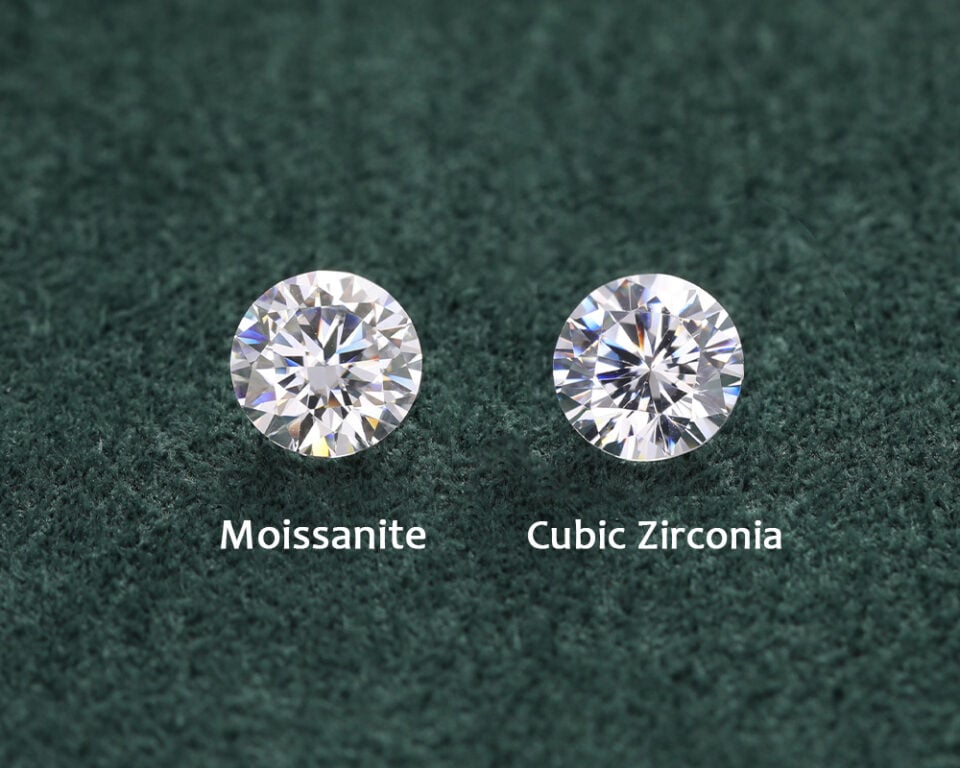
Can all three stones pass the diamond tester?
Can all three stones pass the diamond tester?
Many people use a diamond tester to check if a stone is real, but here’s the catch: moissanite can often “pass” as a diamond on most traditional testers.
Diamond testers work by measuring thermal or electrical conductivity.
-
Natural and lab-grown diamonds conduct heat extremely well, so testers register them as “diamond.”
-
Moissanite, however, also has high conductivity, close enough to trigger the same result. That’s why many standard testers can mistake moissanite for a real diamond. For more interesting facts, please refer to our blog “Does Moissanite Pass a Diamond Tester?“
-
CZ, on the other hand, has poor conductivity, so it will clearly test as “not diamond.”
To get an accurate reading, dual testers (that measure both heat and electrical conductivity) are needed. These advanced tools can differentiate moissanite from real diamonds more reliably.
What are the key points of their price differences?
What are the key points of their price differences?
Now that we’ve explored how moissanite, diamond, and CZ differ in appearance, origins, durability, and cost, let’s take a quick look at what actually drives their price gaps. From rarity and production methods to brilliance and brand perception, here are the main factors that shape their value in the jewelry market.
1. Origin & Rarity
- Natural Diamond: Formed deep within the Earth over billions of years and mined in limited quantities. Its rarity and the high cost of extraction make it the most expensive.
- Lab-Grown Diamond: Has the same chemical structure as a natural diamond but is grown in a lab. Because it skips mining and has a shorter production time, it costs 40–70% less.
- Moissanite: Lab-created from silicon carbide; naturally rare but easily produced in labs, keeping prices accessible.
- Cubic Zirconia (CZ): Fully synthetic and mass-produced, making it the least expensive.
2. Material & Composition
-
Natural & Lab Diamonds: Both are pure carbon crystals with unmatched hardness (10 on the Mohs scale), giving them lasting brilliance and resistance to scratching.
-
Moissanite: Nearly as hard (9.25 on the Mohs scale) and highly durable—excellent for everyday wear.
-
CZ: Softer (around 8–8.5) and more prone to scratching or dulling over time.
3. Brilliance & Appearance
-
-
Diamond (Natural or Lab): Shows a sharp, white brilliance with subtle rainbow flashes—classic and refined.
-
Moissanite: Displays stronger fire and more colorful flashes, often appearing even more sparkly than a diamond.
-
CZ: Brilliant when new, but tends to lose its luster as it gets scratched or dirty.
-
4. Production Cost
-
-
Natural Diamond: Expensive due to mining, labor, and distribution chains, plus brand markups from luxury marketing.
-
Lab-Grown Diamond: Requires advanced technology but is far more cost-efficient to produce.
-
Moissanite & CZ: Both are lab-made with streamlined production, resulting in much lower costs.
-
5. Perceived Value & Tradition
-
Natural Diamond: A timeless symbol of rarity, luxury, and commitment.
-
Lab-Grown Diamond: Offers the same beauty and durability at a friendlier price, appealing to modern, eco-conscious buyers.
-
Moissanite: Loved for its brilliance and ethical affordability.
-
CZ: Popular as a fashion or temporary alternative.
What’s the Best Choice for You?
What’s the Best Choice for You?
With so many options out there, the best choice really depends on what matters most to you — sparkle, budget, symbolism, or long-term durability.
Here’s a quick guide to help you decide:
Choose moissanite if you want maximum brilliance, excellent durability, and the best value for your budget. It’s ideal for couples who want a beautiful, ethical stone without overspending — and without compromising on style.
Choose a lab-grown diamond if you want a traditional diamond look and chemical composition, but with a more sustainable and affordable approach than a mined diamond.
Choose a natural diamond if tradition, rarity, and symbolism are your top priorities — and you’re comfortable with the higher price tag that comes with a quality stone.
Consider cubic zirconia jewelry only if you’re looking for a low-cost or temporary option. It lacks the sparkle and longevity of moissanite and may require replacement sooner.
In the end, your ring should reflect your story, your values, and your future. Moissanite offers a brilliant, meaningful, and guilt-free way to celebrate love — one that’s built to last, just like your commitment. Check our FAQs for more information about moissanite.
Top Picks for You
Top Picks for You
